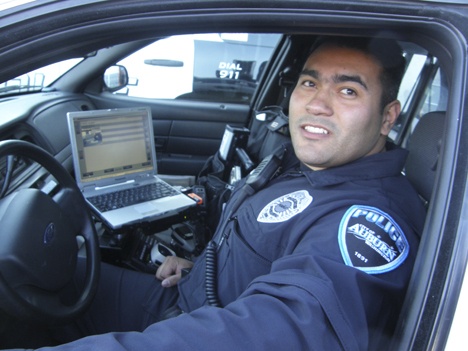It is a labor-saving device, a force-multiplier for police officers like Stan Sedillo as they patrol Auburn’s streets.
But for car thieves, the three cameras on top of Officer Sedillo’s patrol vehicle, the most visible part of a system that can read and check thousands of license plates for stolen vehicles an hour, is one more reason for the bad guys to fear and dread Auburn’s blacks-and-whites.
And while Sedillo’s driving around, those electronic eyeballs above him are always peeled, scanning, freeing him to do other things, releasing him from the time-consuming task of typing plate numbers into his laptop computer.
“Thousands of plates an hour is a lot more than the usual one at a time, and a lot more than I can do just entering manually,” said an appreciative Sedillo.
The Auburn Police Department has had the license plate reader system since February.
Sedillo’s patrol car is outfitted with three cameras. Two of the cameras can run at one time and adjust to face forward during normal driving, and one can be adjusted to the right side to complement a rear camera that is always facing to the right.
As Sedillo drives, the cameras automatically read plates and run them through an internal Auburn police database. A software program is tied into the laptop Sedillo already uses.
If a car has been uploaded into that database as a stolen vehicle, it comes back as a stolen vehicle with an attached warrant.
“After I get that hit on the plate reader system, I still have to run the plate myself to find out if that is still valid and find out what is actually going on with that vehicle, if it’s a warrant attached to the registered owner or if it’s a stolen vehicle somewhere,” said Sedillo.
“It’s operating in the background, so as the officer is doing the normal patrol duties out there, it just happens that now or then the little siren will pop up and the warning will flash on the screen and it will show that plate,” said Assistant Police Chief Larry Miller. “Typically, an officer will look at a plate and say, ‘Yeah that looks suspicious,’ and run it. Well, this is doing that for them, automatically.”
Good in all conditions
The cameras work in all weather conditions, with infrared for night work. They also can take pictures at high speeds.
Typically, four officers are assigned to the car at various times. Miller said the plate reader system doesn’t require a lot of training.
Today the system reads license plates, but Miller noted that it can be set up to enter a lot of additional information, including parking infractions, Amber Alerts and felony warrants.
“Every day, a new hotlist is uploaded into the database, but what’s really nice about ours is it’s done wirelessly,” Miller said. “Most agencies that have this have to use a thumb drive that they come in once a day and enter it. This has the NCIC (National Crime Information Center) list of all stolen vehicles, but we also have the state list and other additional information that we want to upload. And if there are any additional things that are done during the day, it will update our system wirelessly.”
Sedillo’s patrol vehicle is the only one right now in the fleet that has the license plate reader, but as funding permits Auburn police would like to purchase more.
It costs about $30,000 to outfit a car, including a three-year warranty.
To date, the system has run more than 400,000 plates in Auburn and has recovered 22 stolen vehicles resulting in five different arrests.
While the database is internal now, police hope to see the day when they can tap into the City of Kent’s or Seattle’s license plate reader systems using software that will reveal every time a particular plate has been read by their systems and where and when.



